
Slowbalisation reflects the gradual deceleration of global economic integration, marked by reduced cross-border trade and investment flows, while autarky emphasizes national self-sufficiency with minimal dependence on international markets. This shift affects supply chains, trade policies, and economic growth patterns worldwide. Explore the distinct impacts of slowbalisation and autarky on future global economic stability and development.
Why it is important
Understanding the difference between slowbalisation and autarky is crucial for analyzing global economic trends and policy impacts. Slowbalisation describes the gradual reduction of globalization with persistent international trade and cooperation, while autarky refers to complete economic self-sufficiency with minimal external trade. Knowing these distinctions helps businesses and governments make informed decisions on trade, supply chain management, and market expansion strategies in a shifting global landscape. Accurate awareness of slowbalisation versus autarky guides economic resilience planning and international relations.
Comparison Table
| Aspect | Slowbalisation | Autarky |
|---|---|---|
| Definition | Gradual slowdown of global economic integration | Complete economic self-sufficiency, no external trade |
| Trade | Reduced but ongoing international trade | No international trade, reliance on domestic production |
| Supply Chains | Shorter, regionalized supply chains | Fully domestic supply chains |
| Economic Growth | Moderate growth with less globalization-driven expansion | Limited growth due to lack of external markets and resources |
| Resilience | Higher resilience through diversification and regional focus | High self-reliance but vulnerable to domestic shocks |
| Innovation | Innovation supported by regional collaboration | Innovation constrained by limited external knowledge exchange |
| Example Economies | European Union, ASEAN with moderating global ties | North Korea, historical Albania |
Which is better?
Slowbalisation promotes moderate globalization by encouraging regional trade networks and diversified supply chains, enhancing economic resilience and reducing dependency risks. Autarky emphasizes complete economic self-sufficiency, limiting international trade to protect domestic industries but often resulting in inefficiencies and reduced innovation. Economies adopting slowbalisation tend to balance growth and stability better compared to the isolating and resource-intensive nature of autarky.
Connection
Slowbalisation, characterized by the deceleration of global trade growth, often leads countries to pursue autarky as a strategy for economic self-sufficiency and reduced dependence on international markets. This shift results from increasing geopolitical tensions, supply chain disruptions, and protectionist policies that encourage nations to produce domestically. Consequently, the interplay between slowbalisation and autarky reshapes global economic dynamics by prioritizing localized production and limiting cross-border economic integration.
Key Terms
Trade Barriers
Trade barriers in autarky emphasize self-sufficiency through high tariffs, quotas, and import restrictions that limit foreign competition and protect domestic industries. Slowbalisation reflects a nuanced increase in trade barriers, such as selective tariffs and localized supply chains, slowing global integration without fully reversing globalization. Explore the evolving dynamics of trade policies and their impact on global commerce for deeper insights.
Self-Sufficiency
Autarky emphasizes complete economic self-sufficiency by minimizing reliance on international trade and external resources, aiming for national independence in production and consumption. Slowbalisation reflects a moderated globalization trend where countries still engage in trade but prioritize resilience and regional supply chains over global interdependence. Explore in-depth insights on how these approaches shape modern economic strategies.
Global Value Chains
Autarky emphasizes national self-sufficiency by reducing dependence on international trade, disrupting Global Value Chains (GVCs) and limiting cross-border production networks. Slowbalisation reflects a deceleration rather than reversal in globalization, leading to more regionalized and sustainable GVCs with improved resilience against global shocks. Explore how these contrasting approaches reshape the future dynamics of global production and economic interdependence.
Source and External Links
Autarky Meaning - Autarky is an economic policy of self-sufficiency where a country restricts external trade to operate as a closed economy, aiming to reduce dependence on foreign imports.
Autarky - Wikipedia - Autarky refers to self-sufficiency, especially in economic systems, where a state or entity seeks to be independent from external economic, political, or cultural influence, sometimes pursued by various political ideologies to control resources or preserve social order.
Autarky - Overview, History, and Modern World Examples - Autarky means a country or economy operates independently and self-sufficiently, typically refusing trade or outside assistance, functioning as a closed economy.
 dowidth.com
dowidth.com